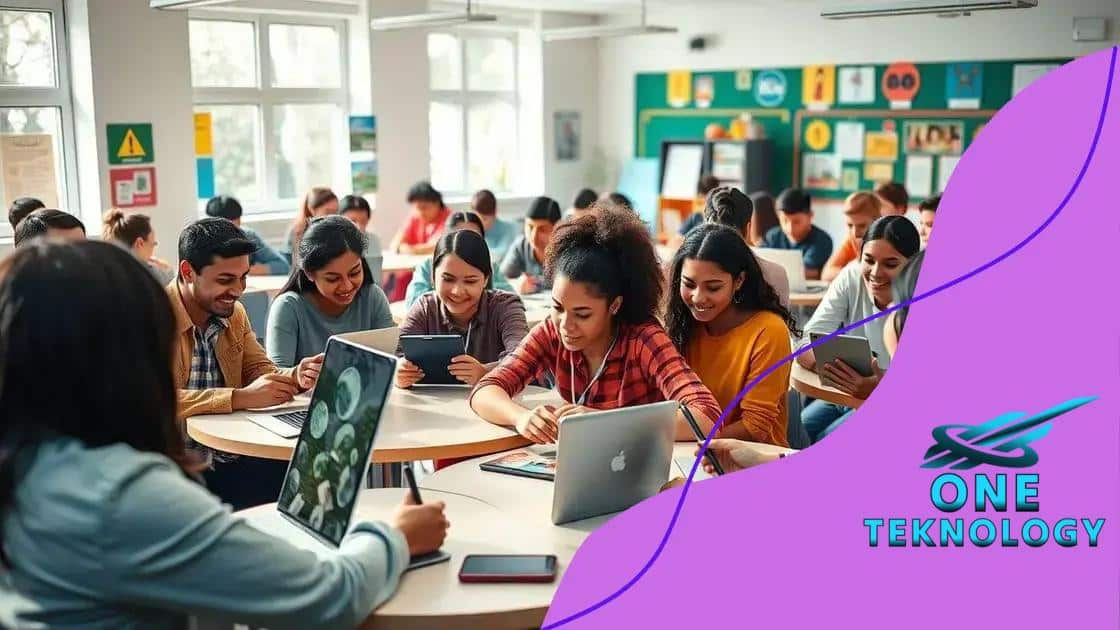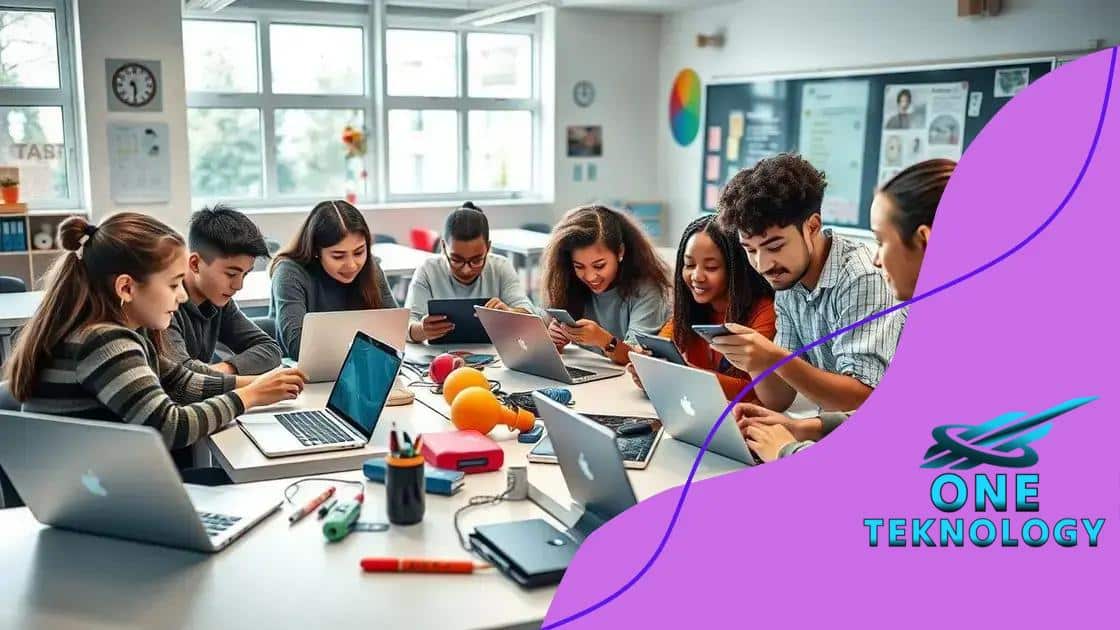The role of technology in creating accessible education

The role of technology in creating accessible education involves leveraging tools like AI, VR, and adaptive resources to ensure all learners, regardless of their abilities, can engage and succeed in their educational journeys.
The role of technology in creating accessible education is more crucial than ever. Have you wondered how tech innovations can open doors for students everywhere? Let’s explore how this landscape is changing and what it means for learners.
Understanding accessible education
Understanding accessible education is essential for fostering inclusivity in learning environments. It ensures that all students, regardless of their backgrounds or abilities, have the opportunity to succeed. This approach not only addresses the needs of students with disabilities but also extends to anyone who may face barriers in accessing quality education.
What is Accessible Education?
Accessible education refers to the methods and practices that make learning opportunities available to everyone. This includes tailored resources and materials that cater to diverse learning styles and abilities.
Key Features of Accessible Education
- Diverse learning materials
- Flexible teaching methods
- Supportive technology
- Inclusive classroom environments
By embracing these features, educational institutions can create spaces where every student feels valued and engaged. Additionally, technology has made significant strides in improving accessibility through tools like text-to-speech software and customizable learning platforms.
Benefits of Accessible Education
One of the main benefits of accessible education is that it promotes equity among students. When educational settings prioritize inclusivity, students can thrive without the fear of being left behind. Furthermore, these practices encourage collaboration and empathy among peers.
Moreover, accessible education leads to a richer learning environment where all voices are heard. Whether through group projects or discussions, students learn from each other, fostering a sense of community.
Challenges in Achieving Accessibility
While the goals of accessible education are clear, there are challenges to overcome. These can include insufficient resources, lack of training for educators, and outdated technologies. It’s crucial for schools and institutions to continually invest in the right tools and training to make education more accessible.
Key technologies improving access
Key technologies play a vital role in improving access to education for all students. These innovations can break down barriers that often hinder learning. With the right tools, educators can create a more inclusive environment.
Assistive Technologies
Assistive technologies are designed specifically to help students with disabilities. They provide essential support and enable these students to participate fully in the classroom. Some examples include:
- Text-to-speech software: This tool helps students with reading difficulties by reading digital text aloud.
- Speech recognition tools: These allow students to write and edit their work using their voice, making it easier for those with physical disabilities.
- Alternative input devices: Tools like adaptive keyboards and switches can assist students who have trouble using standard devices.
These technologies help level the playing field for learners who may struggle in traditional settings.
Online Learning Platforms
Online learning platforms have transformed education by providing accessible resources to students. These platforms often include features that enhance the learning experience:
- Interactive content: Multimedia resources make learning engaging and cater to different learning styles.
- Flexible access: Students can learn at their own pace, allowing them to revisit materials as needed.
- Collaborative tools: Features like discussion boards and group projects encourage interaction among students, fostering a sense of community.
Online platforms not only support conventional learners but also open doors for those who might face challenges in physical classrooms.
Mobile Applications
Mobile applications serve as powerful tools for education. They offer unique features that can further enhance accessibility:
- Learning apps: These cater to various subjects and skills, allowing students to practice and improve.
- Organizational tools: Apps designed for time management help students keep track of assignments and deadlines.
- Accessibility features: Many apps incorporate features like adjustable text sizes and screen readers to support all users.
By integrating mobile apps into their teaching, educators can offer personalized learning experiences.
Impact of technology on learning outcomes

The impact of technology on learning outcomes has been profound, reshaping how students engage with their education. Technology provides new ways for learners to access materials, interact with peers, and showcase their knowledge.
Enhanced Engagement
When students use technological tools, they often feel more engaged in their learning. Interactive features such as multimedia presentations and educational games capture their attention better than traditional methods. With immersive learning experiences, students can explore complex concepts in a fun and interactive way.
Personalized Learning
Technology also facilitates personalized learning. Students can learn at their own pace, revisiting lessons or skipping ahead as needed. This flexibility allows for a tailored approach to education:
- Adaptive learning systems: These programs adjust the content based on the student’s performance.
- Learning analytics: Teachers can track student progress and identify areas needing extra support.
- Diverse resources: A wide range of online materials caters to different learning styles.
This personalized approach helps all students, especially those who may struggle in a traditional classroom setting.
Collaboration and Communication
Technology enhances collaboration among students. Tools like video conferencing and collaborative workspaces enable learners to connect and work together, regardless of their physical location. This encourages different perspectives and ideas, enriching the learning experience.
Additionally, technology simplifies communication between students and educators. Online platforms allow for quick feedback and support, fostering a more dynamic learning environment.
Measurable Learning Outcomes
Finally, measuring learning outcomes has become easier with technology. Educators can utilize various assessment tools to evaluate student understanding effectively. By analyzing results, they can adjust teaching strategies to improve academic performance.
With the help of technology, educational institutions can move toward more effective practices, ensuring that every student can reach their full potential.
Challenges in implementing technology
Implementing technology in education presents various challenges that can hinder the effectiveness of accessible education. While technology can enhance learning, barriers exist that must be addressed for successful integration.
Resource Limitations
One major challenge is the lack of resources. Schools often struggle with limited funding, which can affect their ability to purchase new technologies or maintain existing equipment. This lack of resources can lead to:
- Inadequate infrastructure: Without the necessary hardware and software, effective teaching can’t occur.
- Poor internet access: Slow or unreliable internet can disrupt online learning experiences for students.
- Lack of training: Teachers may not receive the professional development needed to use new technologies effectively.
Without addressing these limitations, schools may fall behind in providing quality education.
Resistance to Change
Another challenge is resistance from educators and administrators. Some may hesitate to adopt new technologies due to fears about effectiveness or the disruption of traditional teaching methods. This resistance can stem from:
- Fear of the unknown: Some educators may feel uncomfortable using unfamiliar tools.
- Comfort with traditional methods: Many teachers prefer the established ways of teaching they know.
- Concerns about equity: There may be fears that not all students have equal access to technology.
Overcoming this resistance requires creating a supportive environment that values innovation.
Training and Support
Providing adequate training and ongoing support is crucial for successful implementation. Educators need to feel confident in their ability to use technology effectively. Unfortunately, many schools do not prioritize professional development, which can lead to:
- Underutilization of resources: If teachers do not know how to use available tools, those tools go unused.
- Inconsistent application: Different teachers may use technology in varying ways, leading to uneven learning experiences for students.
- Burnout: Without proper support, educators may feel overwhelmed by the demands of integrating technology.
To combat these issues, schools should invest in comprehensive training programs that empower teachers.
Future trends in accessible education
Future trends in accessible education are shaping a new era where learning opportunities are expanded for everyone. As technology evolves, so do the ways in which education is delivered, making it more inclusive.
Integration of Artificial Intelligence
Artificial intelligence (AI) is set to transform education significantly. AI can analyze student performance and tailor resources to meet individual needs. This results in:
- Personalized learning experiences: AI-driven platforms can adapt lessons based on student progress.
- Intelligent tutoring systems: These tools offer real-time feedback, helping students learn at their own pace.
- Data-driven insights: Educators can use AI analytics to identify areas where students struggle, informing targeted interventions.
Through AI, educational institutions can create a more responsive learning environment.
Virtual and Augmented Reality
Virtual reality (VR) and augmented reality (AR) are emerging trends that make education more engaging and interactive. These technologies offer immersive experiences that can:
- Enhance understanding: Students can visualize complex concepts in a three-dimensional space.
- Encourage exploration: VR field trips can take students to historical sites or distant planets without leaving the classroom.
- Support diverse learning styles: These tools cater to visual and kinesthetic learners, making content accessible to all.
As these technologies become more available, they will revolutionize traditional teaching methods.
Increased Focus on Equity
The future of accessible education will likely see a growing emphasis on equity. Educators and policymakers are recognizing the need for:
- Universal design for learning: Structuring curricula that accommodate all learning preferences from the start.
- Equitable access to technology: Ensuring all schools have the necessary resources and infrastructure.
- Collaboration with community organizations: Partnerships can provide additional support and resources to underrepresented groups.
By prioritizing equity, educational systems can create an inclusive environment that benefits every learner.
Global Collaboration
Finally, the future will likely see more global collaboration in education. Online platforms enable partnerships across borders, allowing educators to share resources and teaching strategies. This can lead to:
- Exchange programs: Virtual exchanges can connect students globally, fostering cultural understanding.
- Shared teaching materials: Educators can collaborate to create and distribute inclusive resources.
- Collective problem solving: Working together can address common challenges faced by educational systems worldwide.
As schools become more interconnected, accessible education will extend beyond geographical boundaries.
FAQ – Frequently Asked Questions about Accessible Education
What is accessible education?
Accessible education refers to teaching methods that ensure all students, regardless of ability, have equal opportunities to learn and succeed.
How does technology improve accessible education?
Technology enhances accessible education by providing tools like AI, online resources, and assistive devices that cater to diverse learning needs.
What are the main challenges in implementing accessible education?
Challenges include limited resources, resistance to change among educators, and the need for adequate training and support.
What trends can we expect in the future of accessible education?
Future trends include increased use of AI for personalized learning, immersive experiences through VR and AR, and a stronger focus on equity and global collaboration.






